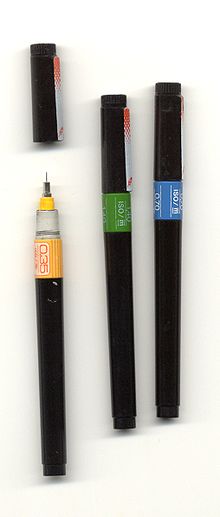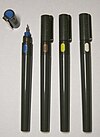Indian ink pen
Pens , even ink pen or ink pen , with standards as ink drawing instruments referred to are, crayons according to DIN 15 , which for technical or bound drawing with tear tracks and machines of engineers , technical draftsmen , cartographers , planners and architects are used. Colloquially, brand names of the manufacturer, such as Rotring "Rapidograph" ("Rapi" for short) or Isograph or Skribent, were and are often used.
With refillable or exchangeable ink cartridges and with defined line widths, they replaced the previously common drawing pen with freely adjustable width. The funnel nib and the ink fountain pen with interchangeable nibs (tubular nibs and flat nibs of different widths) can be seen as forerunners .
Nowadays, technical drawings are mostly created on the computer with CAD programs, so ink pens are rarely used in their original sense. Artists and graphic designers use them as drawing implements.
Working principle
The ink is controlled from a refillable reservoir or a disposable cartridge by means of a helical channel (for pressure equalization) and a plunger that can be moved over the regulating wire located in a thin metal tube and protruding slightly from the writing opening, and is fed evenly through this tube (drawing tube , tubular spring ) that applies the ink to the drawing medium with a constant line width. The diameter of the tube determines the line width. The marking of the different line widths takes place with a colored marking on the pens or with direct lettering in millimeters.
| Line width in mm | Identification color according to ISO 9175 | ISO line width series with identification colors |
|---|---|---|
| 0.10 | Red-brown |

|
| 0.13 | violet | |
| 0.18 | red | |
| 0.25 | White | |
| 0.35 | yellow | |
| 0.50 | brown | |
| 0.70 | blue | |
| 1.0 | orange | |
| 1.4 | green | |
| 2.0 | Gray |
- Various dismantled ink pens
Drawing technique
Drawing carrier
paper
Standard-compliant drawings are usually created on natural, highly transparent paper in accordance with the DIN-ISO 9961 standard. These papers, which can be used for at least 10 years under normal storage, differ in their surface properties; they are produced in smooth or matt.
Depending on the grammage of the paper, faulty lines can be removed up to four times without the drawing becoming unusable. These corrections should be made as directed by the paper manufacturer. Special erasers or pencils are common, and it is also common to plan off the dried ink with razor blades, fiberglass pens or special scrapers. A special ink plane was developed to remove straight lines.
The originals created in this way are reproduced as blueprints or photocopies .
foil
For the processing of original maps or e.g. B. the circuit design of printed circuit boards , transparent PVC plastic films (Astralon or Sicoprint) or coated Mylar films were used as the drawing medium, which are mechanically more resistant and insensitive to moisture. These require the use of special foil inks that loosen the plastic surfaces. For the use of such dissolving inks (e.g. K-Indian ink) suitable ink pens must be used. The plastic parts of these pens are made of non-dissolving ABS plastic and the metal parts are partially protected with a gold layer (example Foliograph, later Isograph F from Rotring made of gray plastic).
The originals processed in this way are reprocessed by means of contact copying on photographic film or by means of foil copies (so-called astralone copies ).
ink
According to the ISO 9957 standard, an ink is an aqueous liquid whose color is determined by the finest black soot dust. This ink must be waterproof, insensitive to temperature and lightfast. A shelf life of at least two years with unopened original packaging is assumed.
Colored inks were also offered outside of this standard. Blue color can not be copied (e.g. in the case of a blueprint ); it cannot be used to make reproductive references to originals. The dissolving inks for plastic drawing foils were also available in different colors for design work.
At the end of the 1970s there were inks made on a latex basis and offered as For Film . This allowed - more badly than right - repro films made of polyester to be designated.
If ink is used instead of Indian ink , the designation ink drawing device is not permitted.
Other uses
Ink pens are also used in pen plotters to draw (plot) a machine plot (e.g. a technical drawing created by CAD ) on paper or foil.
It was also used in measuring recorders and in labeling devices .
equipment
Due to the minimum length and diameter of the drawing tips standardized in DIN-ISO 9175, ink pens are integrated into a whole system of other tools and aids, collectively called drawing tools . The length of the nib, for example, prevents the ink from running under rulers and stencils, as accessory manufacturers have been able to develop a suitable bevel for their tools. The predecessor of this standard, DIN 6775, marked suitable devices with a test mark. The Micronorm symbol was an underlined and underlined lower case letter m .
This symbol was not adopted in the current standard and has therefore been obsolete since June 1990. However, it had proven itself in practice and was probably used later.
Font templates
For the standard fonts specified in DIN 16 and DIN 17, there are templates in different sizes for the respective line widths. There are also non-standardized fonts. At the beginning of the 1980s, electrical labeling devices came onto the market in which ink pens were inserted and size and text could be entered via an alphanumeric keyboard in order to replace the time-consuming labeling with stencils.
Drawing templates
There are special drawing templates for the standardized representation of symbols . For example, circuit symbols for electrical planning or electrical and pneumatic circuits, furniture in standard dimensions in different scales, shape and position tolerances , sanitary objects for planning in the construction sector and chemical structural formulas . Instead of compasses, circular templates with graduated diameters are used for the faster representation of partial or full circles. There are also templates for drawing ellipses , but they only cover a given range of what is mathematically possible.
Use with compasses
The ink pens usually have a thread at the front end. The upper class compass boxes contained special receptacles with the corresponding mating thread for attaching an ink fountain pen. In addition to the most common two-legged compasses, these recordings can also be used in special forms such as zero-point compasses and bar compasses with radii of up to approx. 120 centimeters. Often, however, internal threads on compasses and external threads on ink pens from different manufacturers may not be compatible.
razor blade
Another useful accessory when drawing on tracing paper and other non-absorbent materials is a razor blade. This means that small "snotty noses" that can arise when the Rapidograph is put on can be removed very effectively. However, do not apply too much pressure, otherwise the delicate paper will be damaged. Larger areas are also possible, but such corrections are always visible.
brand names
Various models from the Rotring company , which developed the first ink pens, are sold under the “Rapidograph” brand . The “Isograph” model also comes from her company.
In addition to the global market leader Rotring, other manufacturers of drawing tools also have ink pens on offer. Staedtler sells its pens under the name "marsmatic"; Faber-Castell and Aristo still offer comparable fountain pens on the German-speaking market . In other countries there are suppliers who mostly only supply their local market.
The leading market position of the manufacturer Rotring has led to the fact that ink pens are colloquially called "Rotring" or "Rotring-pen" in the English-speaking world.
In the GDR , until the beginning of the 1980s, ink drawing instruments were manufactured exclusively by Cleo Schreibgeräte (now Cleo Skribent GmbH,) under the Skribent brand , after which there was also a series of ink drawing instruments called lin's 9 plus , which was produced by the Heiko fountain pen factory in Wernigerode (combine Striking ) was produced.
See also
Web links
- Rotring and Rapidograph
- Patent for pen plotter with mention of the Micronorm DIN 6775
Individual evidence
- ↑ Kurt Pribich in collaboration with Helmut Haslinger: Bauelemente Telekommunikentechnik . 5th edition. Bohmann-Verlag, Heidelberg 1971.
- ^ Trademark register: Rapidograph .
- ^ Website Cleo Skribent .
- ^ Trademark register: Cleo Skribent .
- ↑ lin's 9 plus in industrial design of the GDR .











